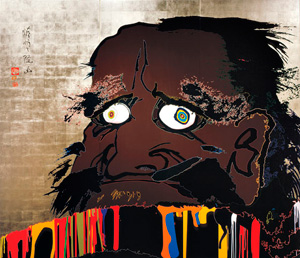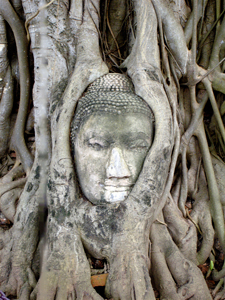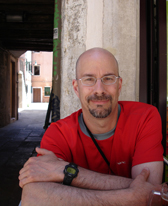The Dilemma of Buddhist Images: Thoughts on Material, Site, and Reception
Series of Lectures and Seminars on October 19 to 23, 2009
Gregory Levine, University of California Berkeley
The Dilemma of Buddhist Images: Thoughts on Material, Site, and Reception
-
Malraux's Buddha Heads
Lecture on Monday, October 19, 6 pm, Karl Jaspers Centre, Voßstraße 2, Room 212
Seminar on Tuesday, October 20, 4 pm, Institute of East Asian Art History, Seminar Room 311 -
A Long Strange Journey: Zen Art and the West
Lecture on Wednesday, October 21, 6 pm, Karl Jaspers Centre, Voßstraße 2, Room 212
Seminar on Thursday, October 22, 4 pm, Institute of East Asian Art History, Seminar Room 311 -
Silenced by Aesthetics? A Conjectural Poetics of Art History and Ecology
Lecture on Friday, October 23, 4 pm, Institute of East Asian Art History, Lecture Room 001
Seminar on Friday, October 23, 6 pm, Institute of East Asian Art History, Seminar Room 311
Malraux's Buddha Heads
Lecture on Monday, October 19, 6 pm, Karl Jaspers Centre, Voßstraße 2, Room 212
Seminar on Tuesday, October 20, 4 pm, Institute of East Asian Art History, Seminar Room 311
 In 1931, André Malraux exhibited in Paris fragments of 4-5th-century Buddhist sculpture from Afghanistan. The exhibition, primarily of torso-less heads, caught the eye of the press, but the undocumented nature of the finds invited harsh comment from the academy. Malraux remained fuzzy about provenience, but he described the fragments as objects rescued from distant sands, exotic to European eyes yet strangely familiar. They commune intimately, he suggests, with the French Gothic; they are works of “Gothic-Buddhist” art. Shortly thereafter a selection of Malraux’s fragments were shown in New York; several entered North American museum collections, including the Museum of Fine Arts, Boston. As works of “Gothic-Buddhist” art, Malraux’s fragments became part of larger modern debates about early Buddhist art and, through his Voices of Silence, were incorporated into his universalist, psychological readings of the formal similarities that appear between works of temporally and geographically distant cultures. Malraux’s fragments prompt a number of questions regarding the modern circulation and reception of Buddhist sculpture. They also provoke reconsideration of the body parts of Buddhist iconic statuary removed from sacred sites in Asia, incorporated into scholarly discourse, resituated within museums and domestic spaces, and replicated in popular and consumer cultures.
In 1931, André Malraux exhibited in Paris fragments of 4-5th-century Buddhist sculpture from Afghanistan. The exhibition, primarily of torso-less heads, caught the eye of the press, but the undocumented nature of the finds invited harsh comment from the academy. Malraux remained fuzzy about provenience, but he described the fragments as objects rescued from distant sands, exotic to European eyes yet strangely familiar. They commune intimately, he suggests, with the French Gothic; they are works of “Gothic-Buddhist” art. Shortly thereafter a selection of Malraux’s fragments were shown in New York; several entered North American museum collections, including the Museum of Fine Arts, Boston. As works of “Gothic-Buddhist” art, Malraux’s fragments became part of larger modern debates about early Buddhist art and, through his Voices of Silence, were incorporated into his universalist, psychological readings of the formal similarities that appear between works of temporally and geographically distant cultures. Malraux’s fragments prompt a number of questions regarding the modern circulation and reception of Buddhist sculpture. They also provoke reconsideration of the body parts of Buddhist iconic statuary removed from sacred sites in Asia, incorporated into scholarly discourse, resituated within museums and domestic spaces, and replicated in popular and consumer cultures.
A Long Strange Journey: Zen Art and the West
Lecture on Wednesday, October 21, 6 pm, Karl Jaspers Centre, Voßstraße 2, Room 212
Seminar on Thursday, October 22, 4 pm, Institute of East Asian Art History, Seminar Room 311
 “Everyone’s looking for something.” Some of us have found it, or part of it, in Zen Art, though the types of things we look at and the sorts of Zen we draw from them may be dramatically different. Indeed, the easily joined words “Zen” and “Art” exist in dynamic tension, grammatically as well as conceptually, and bring to mind other intersections: “East” and “West,” practitioner and scholar, past and present. This paper explores some of the tensions, or perhaps currents and cross-currents, that accompany modern looking at and thinking about Zen Art. It offers an episodic history of the formation and reception of Zen Art in modern era and re-considers, somewhat insistently, figures such as Hisamatsu Shin'ichi and Arthur Waley (and, perhaps, Murakami Takashi). This is not to say that scholarship on works categorized as Zen art is non-existent. One can find countless texts that explain Zen art in aesthetic or philosophical terms. There have also been efforts to consider the rubric “Zen art.” Nevertheless, we’ve yet to grab the ox by the horns and, difficult as it may be, write rigorous histories of the idea and explication of Zen art. This has implications for our interpretation of Zen art objects past and present and leaves noticeable holes in the thorough explication of modernism and postmodernism.
“Everyone’s looking for something.” Some of us have found it, or part of it, in Zen Art, though the types of things we look at and the sorts of Zen we draw from them may be dramatically different. Indeed, the easily joined words “Zen” and “Art” exist in dynamic tension, grammatically as well as conceptually, and bring to mind other intersections: “East” and “West,” practitioner and scholar, past and present. This paper explores some of the tensions, or perhaps currents and cross-currents, that accompany modern looking at and thinking about Zen Art. It offers an episodic history of the formation and reception of Zen Art in modern era and re-considers, somewhat insistently, figures such as Hisamatsu Shin'ichi and Arthur Waley (and, perhaps, Murakami Takashi). This is not to say that scholarship on works categorized as Zen art is non-existent. One can find countless texts that explain Zen art in aesthetic or philosophical terms. There have also been efforts to consider the rubric “Zen art.” Nevertheless, we’ve yet to grab the ox by the horns and, difficult as it may be, write rigorous histories of the idea and explication of Zen art. This has implications for our interpretation of Zen art objects past and present and leaves noticeable holes in the thorough explication of modernism and postmodernism.
Silenced by Aesthetics? A Conjectural Poetics of Art History and Ecology
Lecture on Friday, October 23, 4 pm, Institute of East Asian Art History, Lecture Room 001
Seminar on Friday, October 23, 6 pm, Institute of East Asian Art History, Seminar Room 311

What has Art History to do with Ecology? This essay proposes a sequence of conjectures to enlarge discussion of art historical praxis in an age of ecological decline. How does art history, a system of knowledge, concern itself with systems of organisms and habitats constituting planetary ecology? Do art historians practice according to Commoner’s dictum "…everything is connected to everything else" or Bateson’s relations over relata? How might art history contribute to ecological thinking, perhaps in ways that the natural sciences cannot? Should we make “art objects” “ecological subjects”? Might an “eco-arthistory” move art history away from traditional binary structures?
Gregory P. Levine

is Associate Professor of the Art and Architecture of Japan in the Department of the History of Art, University of California Berkeley, where he has taught since 1997.
He received his B.A. from Oberlin College, M.A. and doctorate from Princeton University (on “Jukōin: Art, Architecture, and Mortuary Culture at a Japanese Zen Buddhist Temple,”) and was a foreign research student for five years at The University of Tokyo and Kyoto University.
Among his recent publications are: “Two (or More) Truths: Reconsidering Zen Art in the West,” in Awakenings: Zen Figure Painting in Medieval Japan (2007) and Daitokuji: The Visual Cultures of a Zen Monastery (2005). His current research focuses on fragments of Buddhist images within devotional and modern contexts in Asia and the West.
His lectures and seminars in Heidelberg are at the center of his forthcoming publications, among them “Malraux’s Buddha Heads” (The Blackwell Companion to Asian Art, 2010). With Yukio Lippit, he is co-editor of the volume Re-Presenting Emptiness: Essays on Zen and Art (Princeton University Press, 2010).
more on the speaker:
Gregory P. Levine, University of California Berkeley
This lectures are funded by the Cluster of Excellence „Asia and Europe in a Global Context: Shifting Asymmetries in Cultural Flows“ at Heidelberg University.


